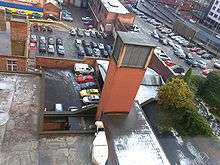Anchor telephone exchange

Anchor Exchange was an underground, hardened telephone exchange built in Birmingham, England. Construction commenced in 1953 under the guise of building an underground railway and opened in September 1957 at a cost of £4 million. [1] It was located nominally on Newhall St.[2][3] However its network of tunnels extended from at least the Jewellery Quarter to Southside.[4]
It originally formed one of a network of 18 Zone Switching Centres within the United Kingdom (UK) telephone system that provided trunk switching facilities within its own charge group and to Group Switching Centres (GSC) within an area broadly comprising the West Midlands and central Wales. The exchange formed part of the trunk mechanisation plan commenced in 1939[5] to permit operators from originating GSCs to dial through to a distant UK subscriber without requiring further operator intervention. Later, it was additionally used to switch subscriber dialled trunk calls after its introduction at Bristol in 1958.
It was subsequently augmented and superseded by a Transit Switching Centre (TSC) equipped with a crossbar switching system (TXK4) which formed part of the Transit Network. It parented two of the first three GSCs at Worcester and Wolverhampton [6] to go-live when the transit network was inaugurated in 1971 which eventually provided universal UK automatic subscriber dialling and was completed in 1979.[7]
The Anchor telephone exchange tunnels are still used to house communication cables. They have been updated with firebreak compartments and hazardous asbestos has been removed. They are continually pumped out because of the city's rising water table.[4]
The exchange took its name from the hallmark of Birmingham Assay Office, which depicts an anchor.
Nuclear Bunker
The exchange is notable for being one of three, along with the Kingsway Exchange in London and the Guardian Exchange in Manchester, that provided hardened facilities in order to protect communications in the event of a nuclear attack during the Cold War in the UK (a fourth one was rumoured to exist in Glasgow, but no evidence of this has been found). [8] In common with most civil defence structures of the time it was designed to withstand an attack by an atomic bomb short of a direct hit. By the time of its completion in 1957, the development of thermonuclear weapons with their significantly increased explosive power, would have reduced the ability to resist an attack. [9]
It has been alleged that the workers involved in the construction were not aware that they were building a nuclear bunker, and they were not allowed to disclose to anyone, not even their close families, the work that they were involved in. [10] The public was told that the project was to provide the city with a new underground rail network, but that by 1956 the project was no longer needed due to costs. [8] There was an entrance at the rear of Telephone House, between Lionel Street and Fleet Street, where there was a strict security check upon entering; this entrance had a heavy blast door weighing about two tonnes. [8] Another entrance was on Newhall Street.
In the event of a nuclear attack, there would have been a 'three-minute warning' to give MPs and Councillors the signal to get from the Council House to the bunker, but was only ever put on full alert during the Cuban Missile Crisis in 1962, and was officially declassified in the late 1960s. [10] By the 1970s and 1980s much of the equipment was obsolete, as of 2014 most of it has been removed due to concerns over asbsetos regulations, but several of the rooms, such as the Mess Room and Canteen, remain intact. [10]
References
- ↑ Birmingham Anchor Exchange Opened - Ness, A. 1958 The Post Office Telephone Network. Student Quarterly Journal. pp 217-219.
- ↑ Ballard, Sebastian (2003-03-19). "Birmingham Anchor Telephone Exchange". Subterranea Britannica. Retrieved 2008-12-02.
- ↑ http://web.archive.org/web/20060506190641/http://www.birminghamanchor.co.uk/
- 1 2 Paul Cole (2 January 2014). "Waiting for Armageddon: The hidden tunnels under Brum". Birmingham Mail. Retrieved 3 March 2015.
- ↑ "Trunk Mechanisation Commenced in UK Network (1939)". Retrieved 8 September 2012.
- ↑ "Transit Network Opened (1971)". Retrieved 8 September 2012.
- ↑ "Full UK Subscriber Dialling Completed (1979)". Retrieved 8 September 2012.
- 1 2 3 Ballard, Sebastian. "Site Name: Birmingham Anchor Telephone Exchange". Subterranea Britannica.
- ↑ "Birminghams Nuclear Bunker (1998)". Retrieved 9 September 2012.
- 1 2 3 Rush, James (29 January 2014). "Inside Birmingham's network of nuclear bunkers and tunnels which would have kept city running in the event of a nuclear strike". The Daily Mail. Retrieved 12 February 2015.
Coordinates: 52°28′58″N 1°54′15″W / 52.4829°N 1.9042°W